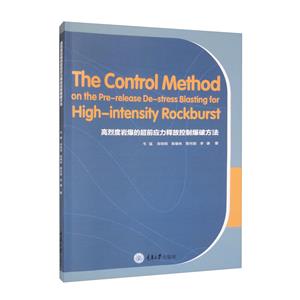中圖網小程序
一鍵登錄
更方便
本類五星書更多>
-
>
公路車寶典(ZINN的公路車維修與保養秘籍)
-
>
晶體管電路設計(下)
-
>
基于個性化設計策略的智能交通系統關鍵技術
-
>
花樣百出:貴州少數民族圖案填色
-
>
山東教育出版社有限公司技術轉移與技術創新歷史叢書中國高等技術教育的蘇化(1949—1961)以北京地區為中心
-
>
鐵路機車概要.交流傳動內燃.電力機車
-
>
利維坦的道德困境:早期現代政治哲學的問題與脈絡
高烈度巖爆的超前應力釋放控制爆破方法 版權信息
- ISBN:9787568925037
- 條形碼:9787568925037 ; 978-7-5689-2503-7
- 裝幀:一般膠版紙
- 冊數:暫無
- 重量:暫無
- 所屬分類:>
高烈度巖爆的超前應力釋放控制爆破方法 內容簡介
本書主要圍繞對強烈巖爆的力學變形機制和超前釋放卸壓爆破方法開展研究,通過以爆(人工工程爆破)治爆(強烈巖爆)方法,提出合理鉆爆參數,為諸多高地應力隧道與地下工程所面臨的巖爆威脅提供解決方案。書中以高烈度巖爆超前應力預釋放卸壓爆破作用機理研究為基礎,結合數值模擬,選用合理的卸壓控制爆破參數,包括炮孔直徑、孔間排距、鉆孔深度、炮孔角度等,并結合現場試驗來探討超前應力預釋放卸壓爆破的有效性和爆破參數的合理性。本書可供從事相關領域工作的教學、科研人員參考,也可作為相關專業研究生的參考書。
高烈度巖爆的超前應力釋放控制爆破方法 目錄
Chapter 1 Introduction
1.1 Background and Significance
1.2 Foreign and Domestic Researches
1.2.1 Current research of rock bursts
1.2.2 Current research of geostress pre-relief controlled blasting
1.2.3 Current research on numerical simulation of the stability of surrounding rocks
1.3 Main Research Contents and Technical Route
1.3.1 Research contents
1.3.2 Technical route
1.4 Expected Target
1.5 Main Innovations
Chapter 2 Factors and Preventing Methods of Rockbursts
2.1 Definition of Rockburst
2.2 Conventional Evaluation Indexes of Rockbursts
2.3 Establishment of Numerical Model for Analyzing Factors of Rockbursts
2.3.1 Introduction to simulation tools
2.3.2 Model establishment and benchmark simulation
2.4 Impact of Rock's Physical and Mechanical Properties on Rockbursts
2.4.1 Qualitative analysis of the impact of rock's physical and mechanical properties on rockbursts
2.4.2 Quantitative analysis of the impact of rock's physical and mechanical properties on rockbursts
2.5 Numerical Analysis of the Effects of Excavating and Supporting Conditions on Rockbursts
2.5.1 Numerical analysis of the effects of full-face excavation and stepwise excavation on rockbursts
2.5.2 Numerical analysis of the effect of supporting conditions on rockbursts
2.6 Recommended Ideas for Controlling High-intensity Rock Bursts
2.7 Summary
Chapter 3 Mechanism of the Pre-release De-stress Blasting for Rockbursts
3.1 Definition of De-stress Blasting
3.2 Microscopic Mechanism of the De-stress Blasting
3.3 Derivation of the Calculation Formula of Residual Stress after De-stress Blasting
3.3.1 Derivation of de-stress blasting equation on two-dimensional plane
3.3.2 Deduction of the de-stress blasting equation on 3-dimensional plane
3.4 Role of the Stress Pre-release Loose Circle
3.5 Factors Influencing De-stress Blasting Effectiveness
3.6 Summary
Chapter 4 Experimental Study on Rock Mechanics of Surrounding Rocks in Tunnels
4.1 Lab Environment
4.2 Test Methods and Results
4.2.1 Uniaxial compressive strength test
4.2.2 Tensile strength test
4.2.3 Normal triaxial compression test
4.3 Summary
Chapter 5 Optimization of Parameters for Pre-release De-stress Controlled Blasting Based on Numerical Simulations
5.1 Response Platforms of Numerical Simulation Analysis
5.1.1 ANSYS/LS-DYNA numerical platform
5.1.2 FIAC 3D numerical analysis platform
5.2 Calculation Process of De-stress Controlled Blasting
5.2.1 ANSYS/LS-DYNA numerical simulation blasting
5.2.2 Coupling process of ANSYS/LS-DYNA and FIAC 3D
5.2.3 Stress release simulation of de-stress blasting in tunnel
5.3 Scheme for the De-stress Controlled Blasting
5.3.1 Overall plan
5.3.2 Design for orthogonal experiment numerical simulation
5.3.3 Design for single factor numerical simulation
5.4 Result Analysis of Numerical Simulations
5.4.1 Result analysis of orthogonal experiment numerical simulation
5.4.2 Result analysis of single-factor numerical simulation
5.5 Summary
……
Chapter 6 On-site Tests of Stress Release by Borehole De-stress Blasting
Chapter 7 Application of De-stress Controlled Blasting in Double-shield TBM Tunnel
Conclusion and Outlook
Acknowledgements
References
1.1 Background and Significance
1.2 Foreign and Domestic Researches
1.2.1 Current research of rock bursts
1.2.2 Current research of geostress pre-relief controlled blasting
1.2.3 Current research on numerical simulation of the stability of surrounding rocks
1.3 Main Research Contents and Technical Route
1.3.1 Research contents
1.3.2 Technical route
1.4 Expected Target
1.5 Main Innovations
Chapter 2 Factors and Preventing Methods of Rockbursts
2.1 Definition of Rockburst
2.2 Conventional Evaluation Indexes of Rockbursts
2.3 Establishment of Numerical Model for Analyzing Factors of Rockbursts
2.3.1 Introduction to simulation tools
2.3.2 Model establishment and benchmark simulation
2.4 Impact of Rock's Physical and Mechanical Properties on Rockbursts
2.4.1 Qualitative analysis of the impact of rock's physical and mechanical properties on rockbursts
2.4.2 Quantitative analysis of the impact of rock's physical and mechanical properties on rockbursts
2.5 Numerical Analysis of the Effects of Excavating and Supporting Conditions on Rockbursts
2.5.1 Numerical analysis of the effects of full-face excavation and stepwise excavation on rockbursts
2.5.2 Numerical analysis of the effect of supporting conditions on rockbursts
2.6 Recommended Ideas for Controlling High-intensity Rock Bursts
2.7 Summary
Chapter 3 Mechanism of the Pre-release De-stress Blasting for Rockbursts
3.1 Definition of De-stress Blasting
3.2 Microscopic Mechanism of the De-stress Blasting
3.3 Derivation of the Calculation Formula of Residual Stress after De-stress Blasting
3.3.1 Derivation of de-stress blasting equation on two-dimensional plane
3.3.2 Deduction of the de-stress blasting equation on 3-dimensional plane
3.4 Role of the Stress Pre-release Loose Circle
3.5 Factors Influencing De-stress Blasting Effectiveness
3.6 Summary
Chapter 4 Experimental Study on Rock Mechanics of Surrounding Rocks in Tunnels
4.1 Lab Environment
4.2 Test Methods and Results
4.2.1 Uniaxial compressive strength test
4.2.2 Tensile strength test
4.2.3 Normal triaxial compression test
4.3 Summary
Chapter 5 Optimization of Parameters for Pre-release De-stress Controlled Blasting Based on Numerical Simulations
5.1 Response Platforms of Numerical Simulation Analysis
5.1.1 ANSYS/LS-DYNA numerical platform
5.1.2 FIAC 3D numerical analysis platform
5.2 Calculation Process of De-stress Controlled Blasting
5.2.1 ANSYS/LS-DYNA numerical simulation blasting
5.2.2 Coupling process of ANSYS/LS-DYNA and FIAC 3D
5.2.3 Stress release simulation of de-stress blasting in tunnel
5.3 Scheme for the De-stress Controlled Blasting
5.3.1 Overall plan
5.3.2 Design for orthogonal experiment numerical simulation
5.3.3 Design for single factor numerical simulation
5.4 Result Analysis of Numerical Simulations
5.4.1 Result analysis of orthogonal experiment numerical simulation
5.4.2 Result analysis of single-factor numerical simulation
5.5 Summary
……
Chapter 6 On-site Tests of Stress Release by Borehole De-stress Blasting
Chapter 7 Application of De-stress Controlled Blasting in Double-shield TBM Tunnel
Conclusion and Outlook
Acknowledgements
References
展開全部
書友推薦
- >
我與地壇
- >
李白與唐代文化
- >
姑媽的寶刀
- >
苦雨齋序跋文-周作人自編集
- >
詩經-先民的歌唱
- >
月亮虎
- >
【精裝繪本】畫給孩子的中國神話
- >
我從未如此眷戀人間
本類暢銷















